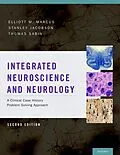Integrated Neuroscience argues that in order to make an intelligent diagnosis and provide a rational treatment nervous system disorders, it is necessary to answer the basic questions of clinical neurology. Where is the disease process located, and what is the nature of the disease process? For students to answer these questions, the authors first review the makeup of the cells within the central nervous system and the development of the regions within the central nervous system. A detailed anatomical overview of the nervous system, starting at the spinal cord, proceeding to the brain stem, diencephalon and cerebrum follows. This textbook focuses not only on localized diseases caused by infectious diseases, trauma, tumors, and vascular lesions within the central nervous system, but also these diseases within the systems of the brain and spinal cord. Over 250 real cases with associated MRI or CTs and any pathological findings from these patients illustrate numerous disorders and fully explain the nature of the pathology. The authors have also included six problem solving sessions in which the student must identify the ongoing disease process, what caused it, and how best to treat it. Throughout the discussion in this text the authors also correlate the neurological findings to the underlying anatomy of the region.
Autorentext
Elliott Marcus is Professor of Neurology (Emeritus), University of Massachusetts School of Medicine Stanley Jacobson is with the Department of Anatomy and Cellular Biology, Tufts University Health Science Schools Thomas Sabin is with the Department of Neurology, Tufts University School of Medicine
Zusammenfassung
Integrated Neuroscience argues that in order to make an intelligent diagnosis and provide a rational treatment nervous system disorders, it is necessary to answer the basic questions of clinical neurology. Where is the disease process located, and what is the nature of the disease process? For students to answer these questions, the authors first review the makeup of the cells within the central nervous system and the development of the regions within the central nervous system. A detailed anatomical overview of the nervous system, starting at the spinal cord, proceeding to the brain stem, diencephalon and cerebrum follows. This textbook focuses not only on localized diseases caused by infectious diseases, trauma, tumors, and vascular lesions within the central nervous system, but also these diseases within the systems of the brain and spinal cord. Over 250 real cases with associated MRI or CTs and any pathological findings from these patients illustrate numerous disorders and fully explain the nature of the pathology. The authors have also included six problem solving sessions in which the student must identify the ongoing disease process, what caused it, and how best to treat it. Throughout the discussion in this text the authors also correlate the neurological findings to the underlying anatomy of the region.
Inhalt
SECTION I: INTRODUCTION TO BASIC NEUROBIOLOGY 1. Overview of the Nervous System 2. Overview of Localization of Function and Neurological Diagnosis 3. Neurocytology: Cells of the Central Nervous System 4. Neuroembryology and Congenital Malformations 5. Skeletal Muscle and Nerve-Muscle Junction SECTION II: REGIONAL APPROACH TO NEUROANATOMY AND FUNCTIONAL LOCALIZATION 6. Spinal Cord Structure and Function 7. Atlas of the Spinal Cord 8. A Survey of Diseases of Peripheral Nerve and Nerve Root 9. Spinal Cord: Clinical Considerations 10. Case History Problem Solving: Part I; Spinal Cord, Nerve Root, Peripheral Nerve, and Muscle 11. Functional Anatomy of the Brain Stem 12. The Cranial Nerves 13. Brain Stem: Clinical Considerations 14. Case History Problem Solving: Part II: Brain Stem and Cranial Nerves 15. Diencephalic Nuclei, Functional Localization, and Atlas of the Diencephalon. SECTION III: MAJOR SYSTEMS 16. Hypothalamus, Neuroendocrine System, and Autonomic Nervous System 17. Cerebral Cortex: Cytoarchitecture, Physiology, and Overview of Functional Localization 18. Motor System and Movement: Part I : Reflex Activity, Central Pattern Generators, and Cerebral Cortical Motor Functions 19. Motor Systems Part II: Basal Ganglia and Movement Disorders 20. Motor Systema Part III: Cerebellum and Movement and Major Fiber Pathways of the Cerebellum 21. Somatosensory Function and the Parietal Lobe 22. Limbic System 23. Visual System 24. Speech, Language, Cerebral Dominance, and the Aphasias 25. Case History Problem Solving: Part IV: Cortical Localization 26. Cerebral Hemispheres: Neuropathology and Clinical Correlation I. Vascular Syndromes 27. Diseases of the Cerebral Hemispheres: II. Non-Vascular Syndromes 28. Case history Problem Solving: Part IV: Cerebral Hemispheres SECTION IV: COMPLEX FUNCTIONS 29. Alterations in Consciousness: Seizures, Sleep, and Coma 30. Learning, Memory, Amnesia, Dementia, Instinctive Behavior, and the Effects of the Early Experience 31. Case History Problem Solving: Part V: General Cases 32. Case History Problem Solving: Part VI: Case History Review with Correlation to Illustrations 33. Atlas of the Cerebrum. BIBLIOGRAPHY
